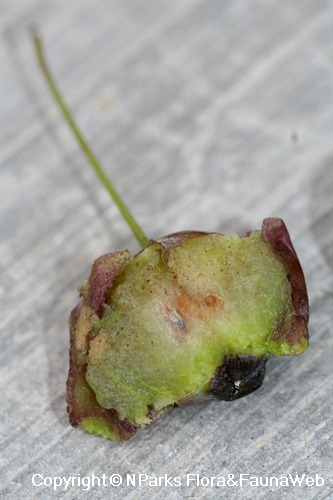
Back
Myrtus communis L.
| Family Name: | Myrtaceae |
| Synonyms: | Myrtus communis var. tarentina, Myrtus communis var. romana |
| Common Name: | Common Myrtle, Sweet Myrtle, True Myrtle, 香桃木 |
Name
Classifications and Characteristics
| Plant Division | Angiosperms (Flowering Seed Plants) (Dicotyledon) |
|---|---|
| Plant Growth Form | Tree (Shrubby (1m-5m)), Shrub |
| Lifespan (in Singapore) | Perennial |
| Mode of Nutrition | Autotrophic |
| Plant Shape | Rounded |
| Maximum Height | 2.5 m to 5.0 m |
| Maximum Plant Spread / Crown Width | 3.0 m to 5.0 m |
Biogeography
| Native Distribution | Mediterranean - northern Africa, western Asia, southeastern Europe |
|---|---|
| Native Habitat | Terrestrial (Grassland / Savannah/ Scrubland) |
| Preferred Climate Zone | Mediterranean |
Description and Ethnobotany
| Growth Form | Dense rounded shrub or small tree, up to 2.5-5.0m tall and wide, pendent when old. |
|---|---|
| Foliage | Leaves glossy dark green, up to 5cm across, aromatic when crushed or brushed against. |
| Flowers | Prominent, produced singly from leaf axils, 3cm across, strongly fragrant, 5 big white petals with many stamens topped with yellow anthers, powerpuff appearance, pollinated by bees and other insects. |
| Fruit | Small purplish-red to bluish-red berries with scented pulp, 1cm across, containing several seeds, eaten and dispersed by birds. |
| Habitat | Native to dry Mediterranean regions. |
| Cultivation | Highly drought-tolerant. Likes well-drained soils. Let soil dry out before watering to avoid leaf-tip chlorosis. Propagate by seeds, semi-hardwood stem cuttings or air-layering. |
| Etymology | Genus epithet 'Myrtus' derived from Greek name for myrtle. Species epithet 'communis' means 'common' or 'growing in groups'. |
| Ethnobotanical Uses | Edible Plant Parts : Edible Fruits, Edible Leaves, Edible Flowers Food (Fruit or Vegetable) (Herb or Spice) Others: Cultural: Plant has long history of cultivation and use. Symbol of love and peace in the Mediterranean, and associated with mythological Greek goddess Aphrodite and Demeter. Culinary: Leaves substitute for rosemary and bay leaves, and used to flavour cooked dishes. Fresh flowers, buds and fruits can be eaten raw in salads. Dried flowers and fruits used as aromatic flavouring for sauces and syrups. Fruits eaten to sweeten breath. Fruits and leaves used to produce Mirto, an aromatic liqueur and national drink of Sardinia. Wood used as high-quality charcoal to impart spicy aromatic taste to grilled food. Medicinal: Leaves contain antiseptic and antibiotic properties, used fresh or dried to treat urinary and chest infections, acne, wounds, gingivitis and dysentery. Products: Essential oils can be extracted from leaves, twigs and flowers to make condiments, perfumes and soaps. Hair dye obtained from fruits. Cut Flower: Leaves and flowers popularly used in wedding bouquets in the Mediterranean. Timber: Wood used to make tool handles, walking sticks and furniture. |
Landscaping Features
| Desirable Plant Features | Ornamental Flowers, Fragrant (Flowers, Foliage, Fruits, Stems) (Day, Time Independent) |
|---|---|
| Landscape Uses | Suitable for Bonsai, Flowerbed / Border, Hedge / Screening, Container Planting |
| Thematic Landscaping | Moonlight Garden, Fragrant / Aromatherapy Garden |
Fauna, Pollination and Dispersal
| Fauna Pollination Dispersal Associated Fauna | Bird-Attracting |
|---|---|
| Pollination Method(s) | Biotic (Fauna) (Insects (Bee)) |
Plant Care and Propagation
| Light Preference | Full Sun, Semi-Shade |
|---|---|
| Water Preference | Moderate Water, Little Water |
| Plant Growth Rate | Fast |
| Rootzone Tolerance | Easy to Grow, Drought Tolerant, Well-Drained Soils, Alkaline high pH Soils |
| Maintenance Requirements | Moderate |
| Pruning | Can be lightly clipped to shape into bonsai, or hard-pruned for hedge. |
| Diseases | Leaves prone to tip chlorosis, if plant is overwatered or grown in poorly-drained soils. |
| Pest(s) | Associated with |
| Propagation Method | Seed, Stem Cutting, Air-Layering |
| Maintenance Requirements Remarks | Allow soil to dry out between watering. |
| Propagation Method Remarks | Pre-soak seeds in warm water for 24 hours before sowing. Use semi-hardwood stem cuttings. |
Foliar
| Foliage Retention | Evergreen |
|---|---|
| Mature Foliage Colour(s) | Green |
| Mature Foliage Texture(s) | Smooth, Glossy / Shiny |
| Foliar Type | Simple / Unifoliate |
| Foliar Arrangement Along Stem | Opposite |
| Foliar Shape(s) | Non-Palm Foliage (Lanceolate) |
| Foliar Venation | Pinnate / Net |
| Foliar Margin | Entire |
| Foliar Apex - Tip | Acuminate |
| Foliar Base | Cuneate |
| Typical Foliar Area | Microphyll ( 2.25cm2 - 20.25 cm2 ) |
| Leaf Area Index (LAI) for Green Plot Ratio | 4.5 (Shrub & Groundcover - Dicot) |
Non - Foliar and Storage
| Trunk Type (Non Palm) | Woody |
|---|---|
| Stem Type & Modification | Woody |
| Root Type | Underground (Fibrous Root) |
Floral (Angiosperm)
| Flower & Plant Sexuality | Bisexual Flowers |
| Flower Colour(s) | White |
|---|---|
| Flower Symmetry | Radial |
| Flower Size - Remarks | 2cm across |
| Flowering Habit | Polycarpic |
Fruit, Seed and Spore
| Mature Fruit Colour(s) | Blue, Purple |
|---|---|
| Fruit Classification | Simple Fruit |
| Fruit Type | Fleshy Fruit , Berry |
Image Repository
Others
| Master ID | 29121 |
|---|---|
| Species ID | 3430 |
| Flora Disclaimer | The information in this website has been compiled from reliable sources, such as reference works on medicinal plants. It is not a substitute for medical advice or treatment and NParks does not purport to provide any medical advice. Readers should always consult his/her physician before using or consuming a plant for medicinal purposes. |









